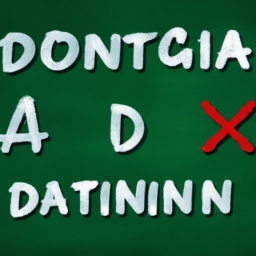Uncovering the Differences Between Domain Rating vs Domain Authority
Domain Rating vs Domain Authority
Domain Rating vs Domain Authority: A Comparative Analysis
Introduction
Gaining an understanding of the major differences between two of the top domain and page rating issues - Domain Rating (DR) and Domain Authority (DA) - is key to success in SEO endeavors. The importance of Domain Rating and Authority has become apparent in today's competitive landscape, where ranking on webpages is heavily reliant on these metrics. To aid in this effort, this article will explore 8 key themes which define, differentiate, and explore the Domain Rating and Domain Authority metrics.
Historical Context
Domain Rating was created by a Ukrainian resident, Denis Shmidov, back in 2014, while Domain Authority was developed by Moz in 2007.Moz one of the major leaders in online marketing at the time was founded by Rand Fishkin and Gillian Muessig and is still used by industry professionals to gauge domain authority. Moz has updated its parameters over the years, enabling it to be more comprehensive and capable of outcompeting other domain rating algorithms.
What is Domain Rating?
Domain Rating is similar to Domain Authority inasmuch as it is a metric used to gauge the power and strength of webpages, with scores ranging from zero to one hundred points. Domain Rating (DR) scores depend on the number and quality of incoming links (inflationary versus deflated). Domain Rating does not include Moz's Link Explorer metrics, but is mainly based on the number and quality of incoming links. It can go up or down depending on the links, unlike Moz's Domain Authority, which checks links weekly and changes at that point.
What is Domain Authority?
Domain Authority is an online marketing metric that compares a website's performance to other websites' rankings in terms of SEO quality, SEO link building effectiveness, and marketing campaigns. Domain Authority links with page optimization but is not considered a replacement or an exclusive substitute for algorithmic rankings. It is a numerical grade, ranging from zero to one hundred, that can predict how well a website will perform in search engine results pages. Generally speaking, a score between one and twenty-five is considered low, while anything above forty should make you competitive.
Key Milestones
One of the most significant milestones for both Domain Authority and Domain Rating occurred when Moz updated its parameters in 2016. Moz designed its updates to focus on multiple indicators such as incoming links, quantity of incoming links, and quality of links, which enabled the metric to better compete with other domain authority score providers. In 2017, Moz also introduced another parameter to its domain authority metrics, which helped distinguish between good and bad links. This milestone allowed Domain Authority to become more sophisticated and be able to drive better value for marketers.
Popular Trends
One popular trend in the Domain Authority and Domain Rating world is the use of high-profile guest-post articles to increase a website's authority score. Seeking out and pitching high-profile guest post opportunities with influential blogs in your industry can help your website gain quality inbound links. Additionally, a popular trend when it comes to Domain Authority is utilizing a Domain Authority Stacking' approach. With this strategy, websites and businesses stack multiple high domain authority websites to boost their own domain authority. This process involves building links from multiple websites and carefully constructing them in such a way that there is an overall boost in Domain Authority.
Potential Pitfalls
When attempting to increase Domain Authority and Domain Rating, there are several potential pitfalls to look out for. Firstly, businesses should watch out for the use of black-hat SEO techniques when attempting to manipulate Domain Authority. It is important to avoid link-building techniques such as buying links, guest articles, or link farms as these can lead to a decrease in the website's domain authority score. Additionally, companies should ensure they do not over optimize their keywords. Over optimizing pages can lead to penalties from search engines.
Insights
Domain Rating and Domain Authority are two of the most important metrics used in SEO today. Gaining an understanding of these metrics as well as the unique differences between them is key to success in SEO endeavors. By understanding the historical context, key milestones, popular trends, and potential pitfalls of Domain Rating and Domain Authority companies can ensure their SEO practices are successful and up to date.
Closing Remarks
Domain Rating and Domain Authority are two of the pillar metrics used to analyze and determine the success of SEO efforts. Companies must keep up to date with these metrics, understand the differences that exist, and be aware of potential pitfalls in order to ensure their campaigns are successful.

